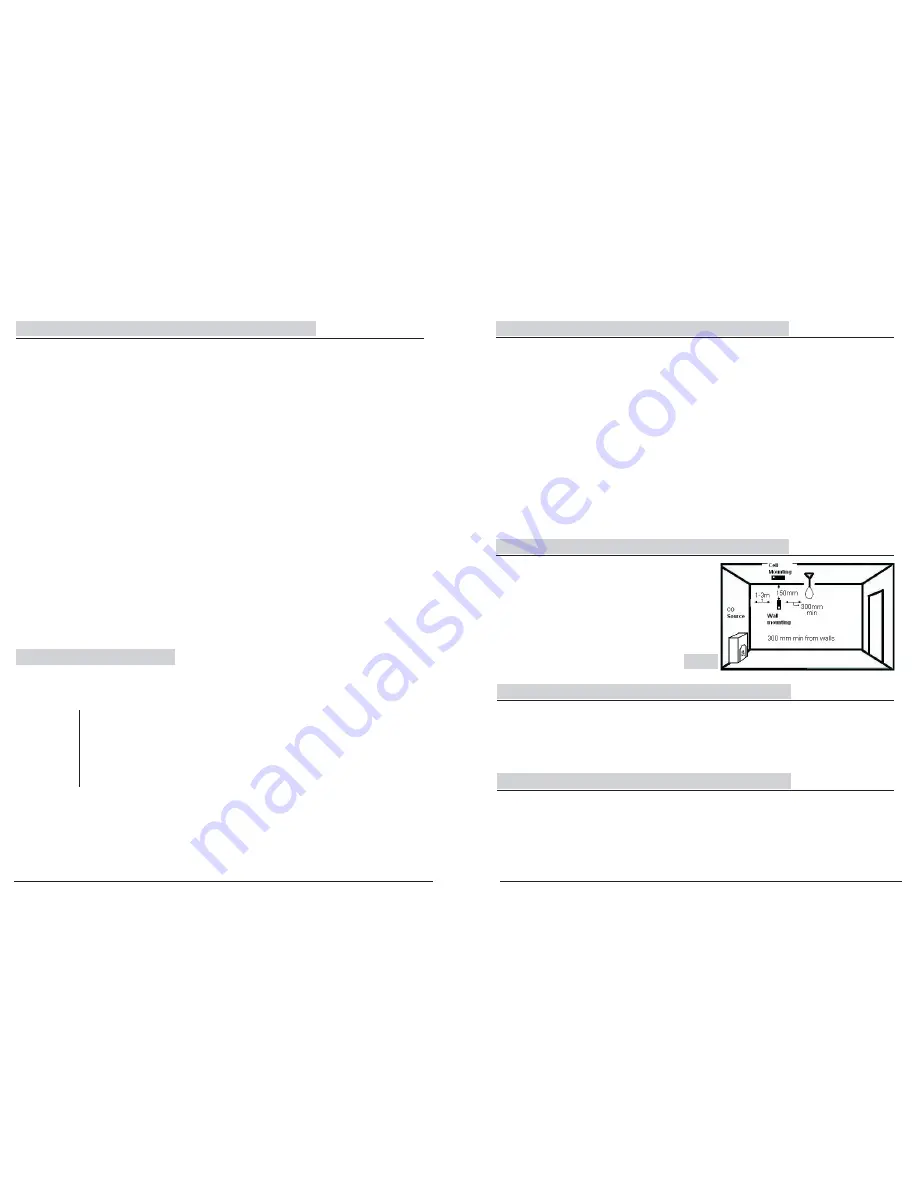
3/8
*Install a CO Alarm in all rooms where there is a fuel burning appliance
*If there is more than one appliance, but only one CO Alarm is to be installed, the following priority list
is recommended:
1.Rooms containing a flue-less or open-flued appliance
2.Rooms where occupants spend most time
3.Rooms in which the appliance is most used
4.If the dwelling is a bedsit the CO alarm should be positioned away from the appliance, but close to
the sleeping area
In an enclosed space e.g a cupboard
Where it can be obstructed
Directly above a sink
Next to a door or window
Next to an extractor fan or vent
Where dirt & dust may block the sensor
In a damp or humid location
In the immediate vicinity of a cooking appliance
CO Alarms should not be located:
6/8
In Alarm Situation
Stay calm. Do not touch any sockets or switches. Do not use any electrical devices. Do not smoke.
Turn off all gas valves.
Immediately evacuate the place, if you don’t know source of gas leakage. Do not interrupt any
electrical device for stopping alarm sound. Inform authorized firm about gas leakage.
Cautions
Do not open or make changes on detector, except making suitable cable connections. Adjustment of
detector must be done by authorized technical services. Alcohol and its’ steams, sprays, saturated
smoke, lighter gas, strong smell of cleaning chemicals confuses and giving wrong alarm by detector.
Use wet packs for cleaning outside of detector. Never use spray or chemicals. Ventilate place and do
not smell any gas leakage.
Carbon Monoxide is an invisible, odourless, tasteless and extremely toxic gas that, if
inhaled, can cause serious ill effects - justifying its name as 'The Silent Killer'. CO is readily
absorbed by haemoglobin in the blood - approximately 240 times more efficiently than
oxygen. This causes serious damage to the heart and brain from oxygen starvation.
Carbon Monoxide originates from the combustion of any fossil fuel -coal, bottled and natural
gas, paraffin, wood, petrol, diesel,charcoal etc.
All Fossil fuel burning appliances produce CO, this is normally vented through flues and
chimneys to the outside atmosphere. However, if the process is not entirely efficient, CO can
build up to dangerous levels. Examples of possible causes are:
*Poorly connected,blocked,cracked or corroded flue pipe/vent
*Back drafting
*Cracked heat exchanger on gas central heating system
*Appliances without flues
Carbon Monoxide poisoning can have a very serious, even fatal, effect on the body.
Unfortunately, most people are unaware that a relatively low level of CO exposure for a
prolonged period can have the same effect as a high level of CO exposure for a short
period. A major problem is that the symptoms of CO poisoning can easily be confused with
other common illnesses - such as cold and flu. The table details the effects of cumulative
CO exposure.
How is CO produced?
What are the main sources of CO?
What are the effects of CO poisoning?
What is CO &
hy does it need to be monitored?
W
The CD310/330/330R Carbon Monoxide Alarm measures the concentration of Carbon
Monoxide and sounds a loud alarm when a potentially harmful level is reached.
CO Parts
Response
per million
CD310 Time
30ppm
120-140 sec
50ppm
60-90 sec
100ppm
10-40 sec
300ppm
2,5 sec
Three separate indicating LED's provide visual information:
Healthy mains supply(Green)
CO level sensed/alarm status(Red)
And if a fault is detected(Yellow)
Alarm Condition
Where should CO Alarms be located?
CEILING MOUNTING
Preferred position in rooms containing
A fuel burning appliance
*1-3m horizontally from the appliance
*At least 300mm from any wall and obstructions
(E.g. light fitting)
Wall Mounting Option
*1-3m horizontally from appliance
*150mm vertically down from ceiling
*Above the height of any doors or windows
Where should CO Alarms be positioned?
Figure: 3




